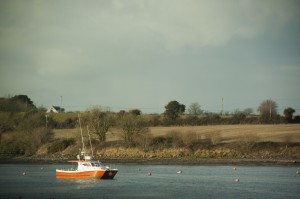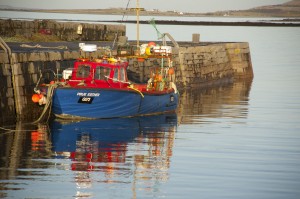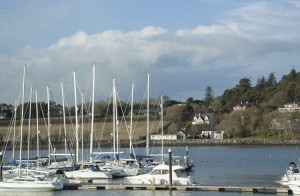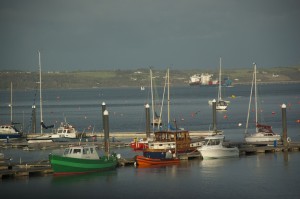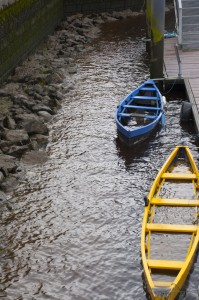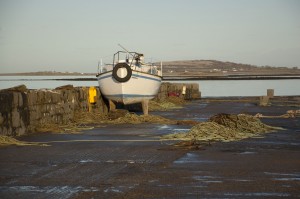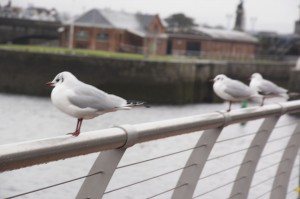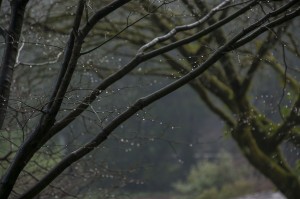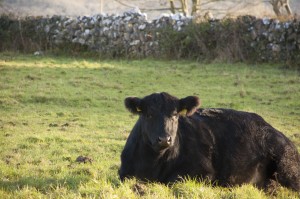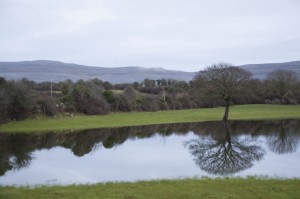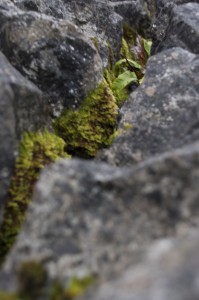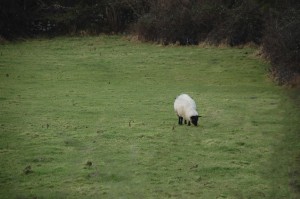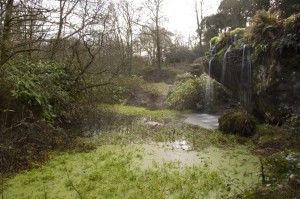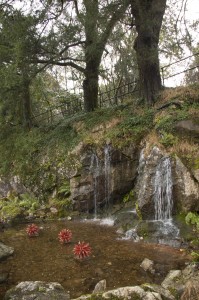The Spirit of Ireland
The rough, gray stones form long, winding fences that weave their way across the hills, having been set firmly in place by people long past. Soft, green moss grows in the cracks, crevices, and corners where the stones meet and along the bumpy edges. The moss continues to grow up several, but not every, rock. The hard sharp edges of these stones have been completely covered and softened by the spongy green foliage. The bumpy edges of the organically shaped rocks fit together surprisingly securely, creating a strong and stable barrier. The jagged surface of the top of the stones causes small pools of water to form on the rough surface, leaving a glossy shine over the stone. The rock wall is as damp and cold as the rain-scented breeze.
A raindrop clings to a leaf as it slowly is pulled towards the stream below. As it reaches the end of the leaf, it sits for a moment, clinging completely still for a moment before falling into the stream below. As it flows, the water dances over and around the stones on the streambed, moving quickly, yet gently towards the ocean. The occasional splash of water leaves the stone walls dark and shiny. Long green and red vines of ivy grow downwards from the top of the wall to the surface of the stream. The green grass mingled among the stones in the shallow stream is visible beneath the cold waters. A gentle breeze moves past, carrying the scent of the recent rain shower with it. The small green leaves on the vines flutter and twirl in the wind, struggling to stay attached to their red stems, then settle back gracefully against the wall. Suddenly, a shower of cool rain begins, the water from the stream mingling with the raindrops before they are whisked away towards the bay. Just as suddenly as it started, the rain stops and the bright blue sky returns, bringing with it a vivid rainbow arching across the sky and rolling hills.
The hills and valleys of the land move and shape the roads, rather than cutting through to make transportation easier, faster, and more convenient. Gray roads, still dark with the recent rain, curve and snake through, around, and between the bright green hills, constantly turning and never moving in one direction for long. At home, streets and roads form squares and rectangles, flattened and smoothed whenever it is deemed necessary and possible, creating a grid on which life takes place, having been specifically designed to make life faster and more direct. Here, winding roads connect to form a series of non-geometric shapes, stitching the earth together in a seemingly random patchwork of green fabric and gray stitches; a puzzle designed around nature. Roads are forced up and down and around the hills, making stomachs turn with each change in direction. Long journeys across the land spontaneously become roller coaster rides. Even the smoothest of roads are filled with turns that sway and lull passengers to sleep, until a sudden bump or sharp change in direction pulls riders out of sleep and into sudden alertness. The long stone walls border each side of the road, keeping the lanes narrow and leaving no sidewalk to speak of. Small patches of grass grow right up against the wall, trapped between the winding road on one side, and the rough rocky border on the other. Hazel grows up and around the stones. Hazel branches reach out to brush against passing cars with long, slender fingers. The dark and willowy branches are tugged forward against the side of the car for a short time before falling back and resting, gently suspended in thin air to await the next passing vehicle. Travelling the roads here becomes about more than getting from one place to the next because moving across the land takes time and commitment; the journey becomes as significant as the destination itself.
On the roads, cars and buses move swiftly around the turns, past the countless historic landmarks which dot the countryside, ancient relics of past lives intermingling and blending in with modern lives. Tombs stand alone and untouched in the middle of fields cleared and divided with stone walls built by hand long ago. Ring forts are seen across the land, ancient mysteries preserved not out of respect of the historic and cultural value the offer, but out of fear of upsetting the ever mysterious and dangerous fairies. An entire highway shifts and moves for the sake of leaving a fairy tree undisturbed by modern life.
In the city, the sides of the roads are dotted not with tombs and ancient artifacts, but with statues, parks, and fountains dedicated to the memories of people who committed their lives to and often died for their country up to two or three hundred years ago. The people here scurry through the roads, weaving in and out of stores, paying as little attention to the numerous street performers as they do the monuments that stand for so much. A child swings in the park, unaware that she plays on the graves of criminals executed here long ago. Medieval men, women, and children, as young as twelve years old, put to death not so much for the sake of justice, but to serve as a warning against others. A few blocks away, the street the window where the mayor executed his own son still stands, a stark reminder of the dark history of this place. Long rows of nearly identical houses line the streets. It is common to find three, four, or five houses in a row, nearly identical, made unique only by the bright colors they have been painted. Around the corner, sits a pub, filled with locals who swap stories they’ve all heard many times before while they sip their Guinness, the sounds of Michael Jackson and U2 filling in the spaces between conversations as new history is created.
***
Life in Ireland
My day begins with raindrops. I wake to the sound of a rain shower softly tapping against the window and thatched roof. Though I am awake, it takes a few minutes for me to convince myself to get up. The warmth of the blankets is much more inviting than the icy air that I know waits for me as soon as I get up. As I get out of bed, I brace myself for the frigid air, and sure enough, I am instantly confronted with an icy blast of the cold morning air. The frozen stillness that surrounds me wakes me up faster than any cup of coffee ever could. I shiver as my bare feet make contact with the cold stone floors. The rain outside passes, but the ever-present clouds remain along with the constant cold dampness of the atmosphere, making me question if it is ever possible to feel truly warm in this country. Outside, raindrops cling in large drops to the branches on the trees and the blades of grass. The constant fog and seemingly unending chill fill the air, settling like a blanket over the village and chilling me to the bone.
Once the rain has passed, though, it is much nicer outside. For once, the sky appears blue, and white fluffy clouds float peacefully past the village without leaving so much as a drop. For the first time in what feels like forever, I can feel the sun on my face and I don’t feel so hurried to make it into a building. I take my time walking back to the small village after class, simply because I can. Cars and buses pass me quickly. I recall a time when I thought I would never feel comfortable sharing such a narrow road with such fast vehicles, but now I barely flinch as they race past me, close enough to reach out and touch.
As I come into town, I stop at the Spar in search of peanut butter and bananas. The small shop carries no more than a few dozen small and sad looking bananas, a stark contrast to the piles of much larger, much yellower fruit I’m used to seeing at home. I’m reminded of a fact I heard once from a local in a small shop, or perhaps it was a pub. Ireland is the largest exporter of bananas. Turns out bananas store quite nicely in cool, damp climates. At home, there are entire aisles dedicated to every brand and variety of peanut butter. Here, you get two choices: chunky or smooth. You would think more choices make life better, but I’ve found I appreciate the simplicity that comes with this small store. Everything I really need is packed within half a dozen aisles, and if it isn’t there, then perhaps I never really needed it after all.
Later, I return to a cold cottage. Knowing it will only get colder once the sun has set, I quickly put together a small fire, being mindful of airflow and being careful not to smother the fire. A bright flame stands out, tall and bright against a backdrop of black. Flames dance and flicker around the peat briquettes, having been arranged carefully into a combination of an A-frame and tepee, a tape-frame, if you will. At the same moment that a trail of smoke rises lazily up the chimney, I recall the case of peat briquettes that claimed it burned smokeless. I don’t mind the false advertising, though. I’m content to just sit and watch as flame wraps around the black bricks, bringing light and the promise of heat. As I sit and begin to read, I find myself frequently looking up to check that the raindrops dripping in from the chimney haven’t put out the fire, but it is still burning strong. At some point, I lose myself in thought; mesmerized as I listen to the soft crackling of the fire and watch the flames dance up and around the briquettes. Suddenly, I realize that twenty, thirty, forty minutes have passed, and no poetry has been read. The warmth from the fireplace slowly fills and heats the quaint yet cozy room. The increase in temperature, combined with the sweet, smoky smell of burning peat makes the whole cottage instantly feel more homey and comfortable.
That night, as I fall asleep, a gentle rain begins yet again, seemingly out of nowhere. It is not the same sort of rain that I awoke to in the morning, though. It is different, heavier yet softer. The full, dense raindrops drum and splash against the cottage, creating a low humming noise on the rooftop. It is a sad, mournful rain, not like the angry drops that pelted the side of the house this morning.
My day ends as it began. A rain shower brings water, necessary for life, but also a constant reminder of the underlying sadness of this place. The town survives on tourists, a cold, seemingly barren place where whole communities struggle together to make ends meet. Life here is simple and the people are resilient out of necessity, kind and trusting of one another because they must to survive. If I have gained one thing over the course of my stay here, it is an appreciation for the small, insignificant things that I have in the past taken for granted: the warmth of my home, the fifty types of peanut butter, the speed at which I can move and travel, the way I can go days without being rained on. At the same time, I know I will miss many things about this place once I leave. I will miss the going to a pub for the free Wi-Fi and staying for the people, kind and generous, and the stories they tell. I will miss spending my evenings by a fire with a cup of tea. I will miss the sheep and the cows grazing in their fields on my way home. Most of all, I will miss how easy and straightforward it is to exist here. I won’t, however, miss the rain.
***
Selected photos from “Ireland & Water”
***
Selected photos from “The Irish Countryside”
